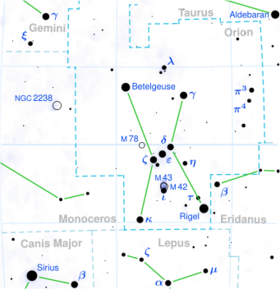Astronomy:56 Orionis
| Observation data Equinox J2000.0]] (ICRS) | |
|---|---|
| Constellation | Orion |
| Right ascension | 05h 52m 26.43865s[1] |
| Declination | +01° 51′ 18.5021″[1] |
| Apparent magnitude (V) | 4.76[2] (4.73 to 4.78)[3] |
| Characteristics | |
| Spectral type | K2-IIb[4] |
| U−B color index | +1.46[5] |
| B−V color index | +1.382±0.005[2] |
| Astrometry | |
| Radial velocity (Rv) | +11.27±0.14[1] km/s |
| Proper motion (μ) | RA: –6.942[1] mas/yr Dec.: –8.355[1] mas/yr |
| Parallax (π) | 2.8794 ± 0.1854[1] mas |
| Distance | 1,130 ± 70 ly (350 ± 20 pc) |
| Absolute magnitude (MV) | −3.14[2] |
| Details | |
| Mass | 6.4±0.7[6] M☉ |
| Radius | 92.21+4.27 −6.72[1] R☉ |
| Luminosity | 2,547±187[1] L☉ |
| Surface gravity (log g) | 0.91[7] cgs |
| Temperature | 4,270+165 −96[1] K |
| Metallicity [Fe/H] | −0.07[7] dex |
| Rotational velocity (v sin i) | 3.5[8] km/s |
| Age | 60.7±18.4[6] Myr |
| Other designations | |
| Database references | |
| SIMBAD | data |
56 Orionis is a single,[10] variable star in the equatorial constellation of Orion. It has an orange hue and is faintly visible to the naked eye with an apparent visual magnitude that fluctuates around 4.76.[2] The star is located at a distance of approximately 1,130[1] light years from the Sun based on parallax.[1] It is drifting further away with a radial velocity of +11 km/s.[1] The star has a peculiar velocity of 19.0+2.9
−3.1 km/s relative to its neighbors, and may be a runaway star.[6]
This object is a bright giant star with a stellar classification of K2-IIb.[4] It is a suspected variable star of unknown type with a brightness that has been measured varying from 4.73 down to 4.78.[3] The star is about 61[6] million years old with 6.4[6] times the mass of the Sun and is spinning with a projected rotational velocity of 3.5.[8] Having exhausted the supply of hydrogen at its core, the star has expanded to 92[1] times the radius of the Sun. It is radiating 2,547 times the Sun's luminosity from its enlarged photosphere at an effective temperature of 4,270 K.[1]
It has one reported visual companion, designated component B, with magnitude 13.5 and angular separation 42.9″.[11]
References
- ↑ 1.00 1.01 1.02 1.03 1.04 1.05 1.06 1.07 1.08 1.09 1.10 1.11 1.12 1.13 Brown, A. G. A. (August 2018). "Gaia Data Release 2: Summary of the contents and survey properties". Astronomy & Astrophysics 616: A1. doi:10.1051/0004-6361/201833051. Bibcode: 2018A&A...616A...1G. Gaia DR2 record for this source at VizieR.
- ↑ 2.0 2.1 2.2 2.3 Anderson, E.; Francis, Ch. (2012). "XHIP: An extended hipparcos compilation". Astronomy Letters 38 (5): 331. doi:10.1134/S1063773712050015. Bibcode: 2012AstL...38..331A. Vizier catalog entry
- ↑ 3.0 3.1 Samus, N. N.; Kazarovets, E. V. et al. (2017). "General Catalogue of Variable Stars". Astronomy Reports 61 (1): 80–88. doi:10.1134/S1063772917010085. Bibcode: 2017ARep...61...80S. http://www.sai.msu.su/gcvs/gcvs/. Retrieved 2019-11-23.
- ↑ 4.0 4.1 Keenan, Philip C.; McNeil, Raymond C. (1989). "The Perkins catalog of revised MK types for the cooler stars". Astrophysical Journal Supplement Series 71: 245. doi:10.1086/191373. Bibcode: 1989ApJS...71..245K.
- ↑ Mallama, A. (2014). "Sloan Magnitudes for the Brightest Stars". The Journal of the American Association of Variable Star Observers 42 (2): 443. Bibcode: 2014JAVSO..42..443M.Vizier catalog entry
- ↑ 6.0 6.1 6.2 6.3 6.4 Tetzlaff, N. et al. (January 2011). "A catalogue of young runaway Hipparcos stars within 3 kpc from the Sun". Monthly Notices of the Royal Astronomical Society 410 (1): 190–200. doi:10.1111/j.1365-2966.2010.17434.x. Bibcode: 2011MNRAS.410..190T.
- ↑ 7.0 7.1 Earle Luck, R. (2014). "Parameters and Abundances in Luminous Stars". The Astronomical Journal 147 (6): 137. doi:10.1088/0004-6256/147/6/137. Bibcode: 2014AJ....147..137L.
- ↑ 8.0 8.1 De Medeiros, J. R.; Mayor, M. (1999). "A catalog of rotational and radial velocities for evolved stars". Astronomy and Astrophysics Supplement Series 139 (3): 433. doi:10.1051/aas:1999401. Bibcode: 1999A&AS..139..433D. Vizier catalog entry
- ↑ "56 Ori". SIMBAD. Centre de données astronomiques de Strasbourg. http://simbad.u-strasbg.fr/simbad/sim-basic?Ident=56+Ori.
- ↑ Eggleton, P. P.; Tokovinin, A. A. (September 2008). "A catalogue of multiplicity among bright stellar systems". Monthly Notices of the Royal Astronomical Society 389 (2): 869–879. doi:10.1111/j.1365-2966.2008.13596.x. Bibcode: 2008MNRAS.389..869E.
- ↑ Mason, Brian D. et al. (2001). "The 2001 US Naval Observatory Double Star CD-ROM. I. The Washington Double Star Catalog". The Astronomical Journal 122 (6): 3466. doi:10.1086/323920. Bibcode: 2001AJ....122.3466M. Vizier catalog entry
 |


